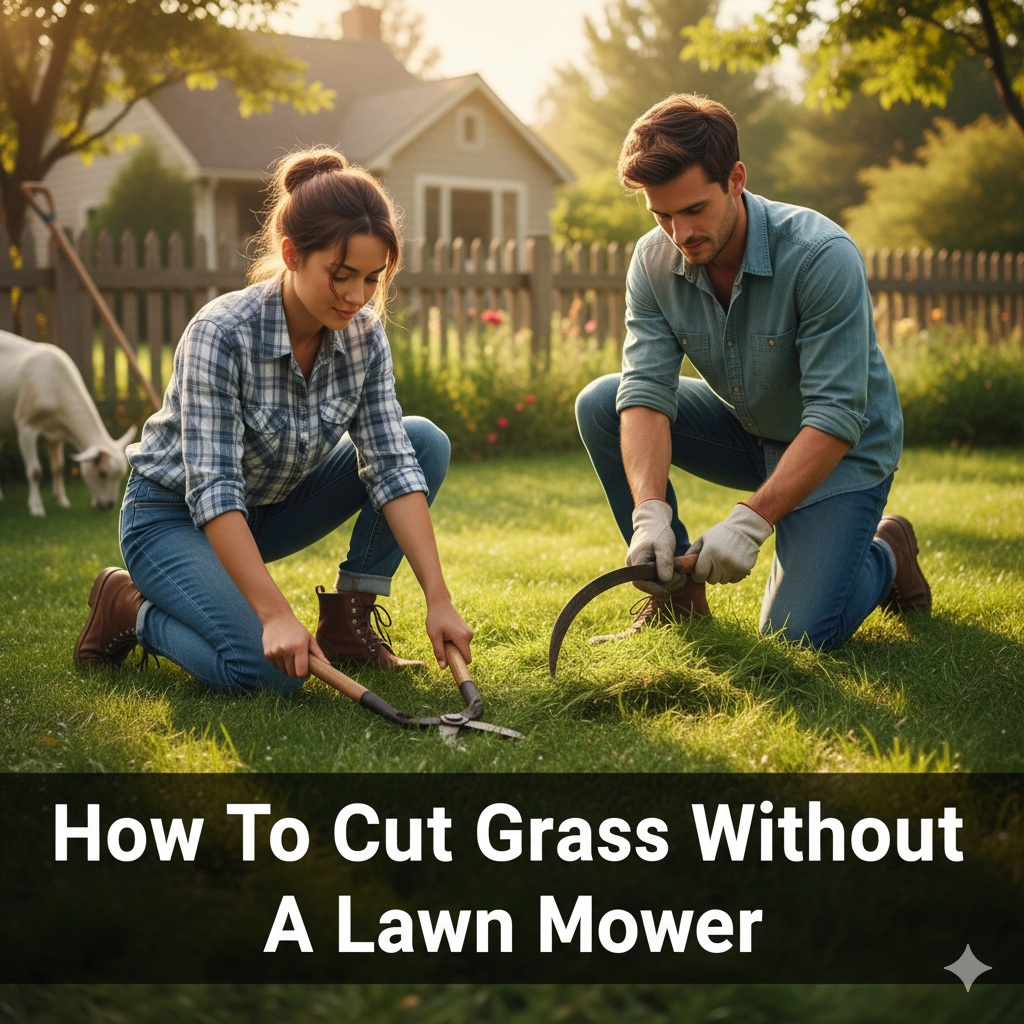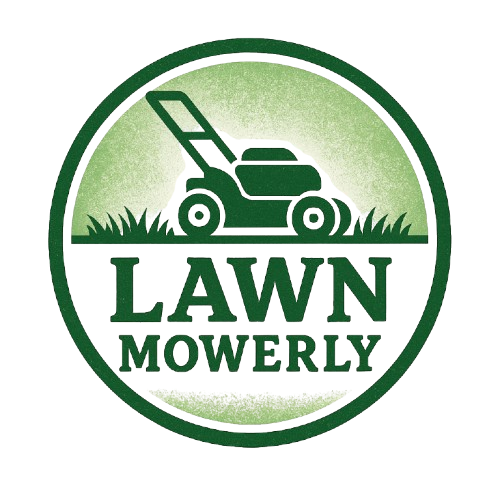
Whether your lawn mower is broken, out of fuel, or you simply want a quieter, eco-friendly alternative — don’t worry. You can cut, trim, and maintain your grass without a traditional mower using simple tools and techniques that work just as well for small or medium-sized lawns.
In this guide, I’ll share the best methods to cut grass without a mower, the pros and cons of each, and some eco-friendly maintenance tips to keep your lawn healthy and neat.
🌱 Why You Might Need to Cut Grass Without a Mower
There are plenty of situations where you might not have (or want) to use a mower:
- Your mower won’t start or needs repair.
- You live in a small space or apartment with a patch of grass.
- You prefer a manual, noise-free method.
- You’re maintaining tricky spots like corners or slopes.
- You want to reduce emissions and save on fuel or electricity.
Whatever your reason, there are several effective manual or mechanical alternatives.
⚙️ 1. Use a Grass Scythe (Traditional & Powerful)
A scythe is an old-fashioned yet effective manual tool that’s great for cutting long or overgrown grass. It consists of a long curved blade attached to a wooden handle.
✅ How to Use:
- Hold the handle with both hands, standing upright.
- Swing the blade in smooth, sweeping motions close to the ground.
- Keep the blade sharp for clean cuts.
🌿 Best For:
- Large, overgrown lawns or fields.
- Cutting wet or thick grass.
⚖️ Pros:
- Quiet and fuel-free.
- Great workout!
- No maintenance beyond sharpening.
❌ Cons:
- Requires practice for consistent cutting.
- Not ideal for small lawns or uneven terrain.
💡 Pro Tip: Keep your scythe blade sharp using a whetstone before every session.
✂️ 2. Use Grass Shears (Perfect for Small Lawns)
Grass shears are like large scissors designed for trimming grass. They’re ideal for small yards or areas around flower beds.
✅ How to Use:
- Hold the shears at the base of the grass.
- Snip horizontally in short strokes.
- Move systematically across your lawn.
🌿 Best For:
- Small patches of grass.
- Tight corners or edges.
⚖️ Pros:
- Lightweight and easy to handle.
- Precise trimming for decorative areas.
- Inexpensive and low-maintenance.
❌ Cons:
- Time-consuming for large lawns.
- Can strain hands or wrists after long use.
💡 Tip: Choose rotating-handle shears for easier grip and reach.
🪚 3. Use a Manual Reel Mower (The Modern Eco Option)
If you want the benefits of a mower without gas or noise, a manual reel mower is perfect. It uses rotating blades that cut grass cleanly as you push it.
✅ How to Use:
- Push steadily forward across your lawn.
- Adjust blade height based on grass length.
- Empty the grass catcher periodically.
🌿 Best For:
- Small to medium lawns.
- Flat, even yards.
⚖️ Pros:
- Eco-friendly and silent.
- Healthier cuts that reduce grass stress.
- Low-cost maintenance.
❌ Cons:
- Not ideal for tall or wet grass.
- Requires physical effort on uneven lawns.
🧠 Pro Tip: Sharpen reel blades every season for smoother operation.
🔪 4. Use a Hedge Trimmer (Electric or Cordless)
A hedge trimmer can double as a grass cutter, especially for long grass or slopes. You can use it to trim down tall growth safely and quickly.
✅ How to Use:
- Hold trimmer horizontally, just above ground level.
- Sweep in slow, controlled motions.
- Rake clippings afterward for a clean finish.
🌿 Best For:
- Overgrown areas or uneven ground.
- Cutting grass near fences or rocks.
⚖️ Pros:
- Quick and effective.
- Great for tough or dense patches.
- Can be electric or battery-powered.
❌ Cons:
- Risk of hitting dirt or stones.
- Uneven cut if used carelessly.
⚠️ Safety Tip: Wear safety glasses and gloves — stones or debris can fly up.
⚔️ 5. Use a Weed Whacker or String Trimmer
A string trimmer (also called a weed eater or weed whacker) is one of the most popular alternatives to a lawn mower. It cuts grass using a fast-spinning nylon string.
✅ How to Use:
- Hold the trimmer so the string spins parallel to the ground.
- Sweep in a gentle side-to-side motion.
- Trim gradually to maintain an even height.
🌿 Best For:
- Trimming grass on slopes or near walls.
- Medium lawns or hard-to-reach areas.
⚖️ Pros:
- Versatile and quick.
- Easy to maneuver around obstacles.
- Works on thick grass and weeds.
❌ Cons:
- No precise height adjustment.
- Can damage grass if overused.
- Needs protective gear for safety.
💡 Pro Tip: Use a battery-powered trimmer for eco-friendly operation without fumes.
🔥 6. Use a Sickle (For Small Patches or Corners)
A sickle is similar to a scythe but smaller — a handheld curved blade perfect for cutting small grassy areas or trimming edges.
✅ How to Use:
- Hold the handle firmly with one hand.
- Swing the blade in short, controlled arcs.
- Collect cut grass afterward.
🌿 Best For:
- Tiny yards, ditches, and edges.
- Overgrown corners and around trees.
⚖️ Pros:
- Portable and affordable.
- Ideal for precision work.
- Great for trimming neglected patches.
❌ Cons:
- Slower than powered tools.
- Can cause hand fatigue with long use.
🔋 7. Use a Brush Cutter (For Tough or Tall Grass)
If your grass has grown knee-high or includes weeds and small brush, a brush cutter is your best friend. It’s a more powerful version of a string trimmer with a metal blade.
✅ How to Use:
- Wear protective gear (gloves, eye protection, boots).
- Move the blade side-to-side in steady motions.
- Clear debris before and after cutting.
🌿 Best For:
- Fields or neglected lawns.
- Areas with thick weeds or shrubs.
⚖️ Pros:
- Extremely powerful.
- Handles heavy growth easily.
- Great for rural or large plots.
❌ Cons:
- Requires strength and safety precautions.
- Louder and heavier than other options.
⚠️ Tip: Always check for rocks or metal objects before cutting — blades can shatter on impact.
✂️ 8. Use Electric Grass Clippers
For smaller, urban lawns, electric or battery-powered clippers can trim grass neatly, just like trimming hair.
✅ How to Use:
- Hold the clipper at ground level.
- Trim in a systematic grid pattern.
- Collect trimmings afterward.
🌿 Best For:
- Small gardens or terraces.
- Quick maintenance between mowing sessions.
⚖️ Pros:
- Compact and easy to use.
- Lightweight and quiet.
- Perfect for decorative lawns.
❌ Cons:
- Not efficient for large areas.
- May need frequent recharging.
🧤 9. Pull or Cut by Hand (For Tiny Areas)
If you have just a few patches of long grass, manual trimming by hand with pruning shears or scissors works too.
✅ How to Use:
- Grab a bunch of grass.
- Cut across with sharp scissors or shears.
- Repeat until even height is achieved.
🌿 Best For:
- Balconies, courtyards, or tight spaces.
- Touch-up trimming near flower beds.
⚖️ Pros:
- Requires no power or fuel.
- Great for small maintenance tasks.
❌ Cons:
- Time-consuming.
- Can cause hand strain.
🐄 10. Let Nature Do It — Natural Lawn Control
If you live rurally, you can let goats, sheep, or rabbits “mow” your grass naturally! They’ll graze evenly, fertilize the soil, and reduce mowing frequency.
✅ How to Use:
- Fence off areas for controlled grazing.
- Move animals periodically to avoid overgrazing.
🌿 Best For:
- Large rural properties.
- Eco-conscious homeowners.
⚖️ Pros:
- 100% natural and sustainable.
- Enriches soil naturally.
❌ Cons:
- Requires animal care and fencing.
- Not practical in small yards.
🧠 Fun Fact: Goats can mow uneven terrain better than most machines!
💡 Tips for Maintaining a Lawn Without a Mower
- Trim Regularly: Don’t let grass exceed 4 inches — it’s easier to manage shorter growth.
- Sharpen Blades Often: Whether it’s a sickle, shears, or scythe, sharp tools make cleaner cuts.
- Water After Cutting: It helps grass recover and reduces stress.
- Rake and Compost Clippings: Grass clippings are excellent mulch or compost material.
- Fertilize Naturally: Use organic fertilizers or compost to keep soil rich.
✅ Regular trimming prevents weeds and promotes even, lush grass.
🧩 Model-Wise Lawn Alternatives (If You Don’t Have a Mower)
| Lawn Size / Type | Best Alternative Tool | Examples / Models |
|---|---|---|
| Small (under 200 sq. ft.) | Grass shears / clippers | Gardena 8885-U, WORX WG801 |
| Medium (200–800 sq. ft.) | Manual reel mower | Scotts 2000-20, Fiskars StaySharp |
| Large (800+ sq. ft.) | Scythe or brush cutter | Husqvarna 336FR, Stihl FS 55 |
| Uneven / Sloped lawn | String trimmer | EGO Power+ ST1511T, Ryobi 40V |
| Overgrown / Weedy | Brush cutter | Stihl FS 91, Makita EM2650LHN |
🧠 FAQ: Cutting Grass Without a Lawn Mower
1. What can I use instead of a lawn mower?
You can use a manual reel mower, scythe, grass shears, weed trimmer, or brush cutter, depending on lawn size.
2. Can I use scissors to cut grass?
Yes, for small patches or detailed trimming. Use garden or pruning shears for efficiency.
3. What’s the best eco-friendly alternative to a mower?
A manual reel mower — it’s quiet, pollution-free, and great for small to medium lawns.
4. Can I use a hedge trimmer to cut grass?
Yes, but keep it just above ground level and wear safety gear to avoid hitting soil or stones.
5. How often should I trim grass manually?
Once every 7–10 days during growing season. Keeping it short prevents thick overgrowth.
6. Is cutting grass by hand bad for the lawn?
No — if done correctly, it can even result in healthier grass since manual tools don’t compact soil.
7. Can I cut wet grass without a mower?
Yes, but it’s harder and may cause uneven cuts. Use a scythe or string trimmer carefully.
8. Do animals help maintain lawns?
Yes! Goats and sheep are natural grazers — an eco-friendly mowing alternative for large spaces.
🌾 Final Thoughts
Cutting grass without a mower isn’t just possible — it can be quiet, eco-friendly, and rewarding.
Whether you use a manual reel mower, string trimmer, or traditional scythe, maintaining your lawn can still be easy with the right tools and techniques.
So, the next time your mower breaks down or you want a peaceful yard day, grab your manual tools — and enjoy a greener, cleaner, fuel-free lawn care experience!
📚 References
- Penn State Extension: Small Lawn Maintenance Tips
- EPA Lawn Equipment Guide: Reducing Emissions with Manual Tools
- Royal Horticultural Society (RHS): Grass Cutting by Hand
- Gardena Tools: Manual and Electric Grass Cutting Equipment

I’m David man behind Lawn Mowerly; I’ve been dealing with lawnmowers and Tractors with my father since I was a kid. I know every make and model and what each one is capable of and love helping people find the perfect equipment for their needs.
